Kraków 2007-07-24
197 Section 1964-06-01
OKB Suchoj Su-7 B (BM, BKŁ, U)
History - Poland
Supersonic direct support aircraft and nuclear strike.
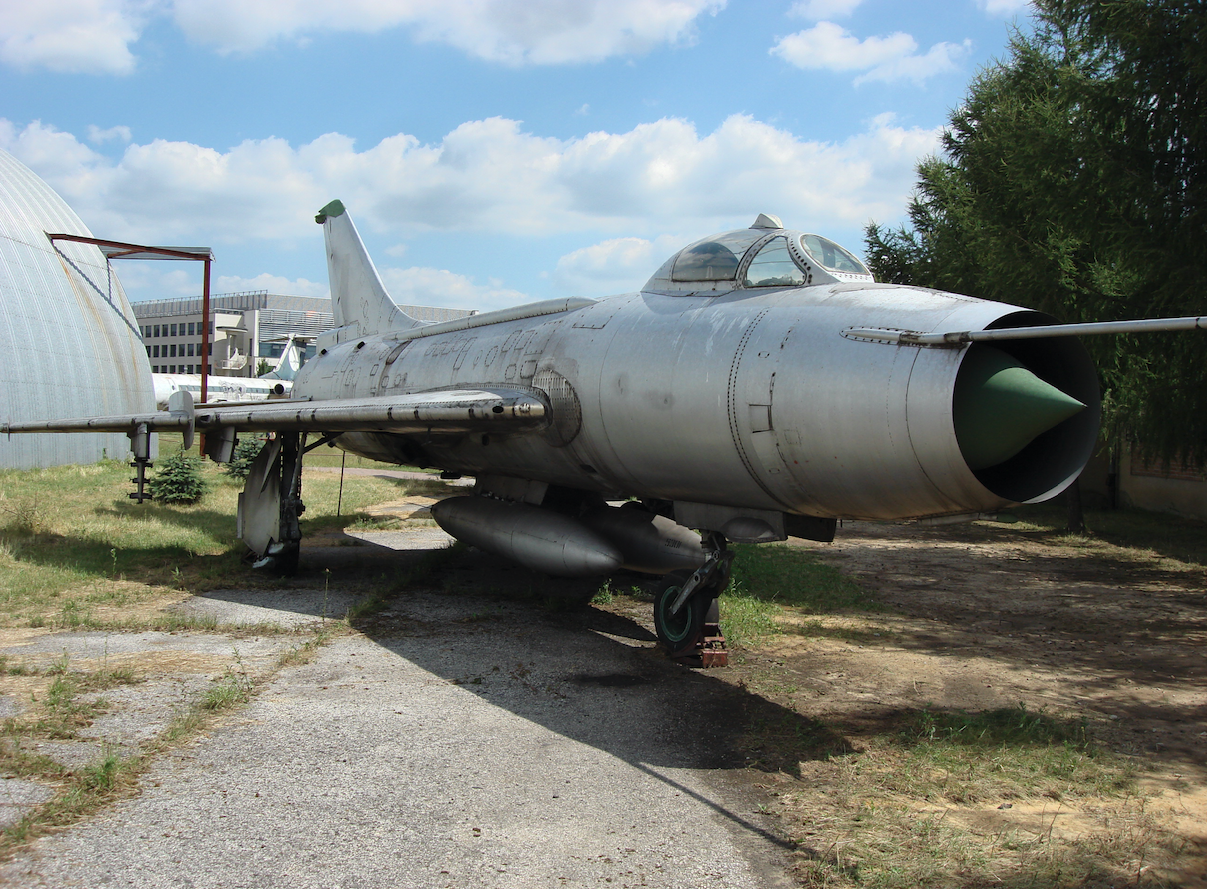
Why did Poland need the Su-7 B plane?
In the 1950s, the Cold War was already developed. Poland, like other countries, was thinking about defense against possible aggression. But Moscow has appointed Poland the role of an aggressor. There was a document entitled - Defense Doctrine of the Polish People's Republic. The doctrine was developed in Moscow for each of the dependent countries under the Warsaw Pact. The document was super secret, and only a small group of generals had access to it.
The document included, among others, the following statements;
"... One of the guiding principles of our operational doctrine has become the view that nuclear-missile weapons are now the main means of solving tasks ..."
"... The operational doctrine of the Polish armed forces is subordinated to the general strategic doctrine of the forces of socialism. Without denying the importance of defense, we give priority to offensive actions. The operational tasks of Poland under the Armed Forces of the Warsaw Pact provide that after the outbreak of armed conflict, Polish Forces are to develop offensive operations north-coastal operational direction, 500 - 800 km deep, 200 to 250 km lane, 60 to 80 kilometers per day ...”
What was the attack on Western countries supposed to look like?
Poland was to prepare two armies for the attack - armored and mechanized. Their advance towards Denmark was planned. They were to be supported by the so-called ABROT, i.e. the Armed Forces of Operational-Tactical Missiles and bombing fighters equipped with nuclear weapons. ABROTs were equipped with R-170 and then R-70, R-300 missiles.
Air tasks were assigned to one air regiment. In the "W" situation, i.e. the outbreak of war, the CCCP military was to provide nuclear weapons for these aircraft, as well as for the ABROT formation.
The procedure of handing over warheads and bombs was a great secret. Secrets of Poland's atomization were in sealed envelopes, kept in safes of the next first secretaries of the PZPR, bearing the inscription: "Open in the event of war". The envelopes were destroyed in 1989 at the behest of general Wojciech Jaruzelski.
The Soviets planned simultaneously with the attack of conventional forces, to support the attack of Polish troops, a nuclear attack on the strategically important port in Esbjerg, and ... dropping an atomic bomb on Copenhagen. This missile was supposed to drop a Polish pilot…
To such an attack, NATO could only respond in one way: with a nuclear missile attack on Polish territory. NATO would not attack the territory of the GDR and West Germany because of the armies of both sides. The attack on CCCP territory was not considered, at least in this phase of the war. Why? Because the Soviets would respond with a massive nuclear attack on the US, using intercontinental missiles.
Poland would cease to exist.
The method of atomic attack made by the plane.
The best way of dropping an atomic bomb was considered to be reaching the target at high speed just above the ground, rapidly gaining height, unhooking the bomb in an ascending flight, and then - after the turn of the war - quick escape at low altitude. This method ensured imperceptible approach to the target, and then time to move away from the place of bomb explosion and the zone of its destruction. It should also be remembered that the atomic bomb does not require a steering system, because its firepower is enormous.
Which plane is right for a nuclear attack?
At the end of the 1950s, Poland had an Iliuszyn Ił-28 bomber with a subsonic speed and a payload of 3,000 kg. This type was not suitable for a quick nuclear attack. Our military successors to the reconnaissance bomber Iliuszyn Il-28 saw in the Yakovlev Yak-26/27/28 aircraft. However, these aircraft were never exported, and in CCCP itself they were never officially accepted.
In this situation, Poland had to buy new equipment - Suchoj Su-7 B. The 3rd Air Regiment was appointed to operate them, which was located in Bydgoszcz.
Suchoj Su-7 B
The Su-7 B was suitable for nuclear attack tasks due to its high speed, high payload, powerful engine, adequate range.
The prototype of the Su-7 B fighter-bomber version was marked with the index S-22-1, and its base became one of the last serially-built Su-7 fighter aircraft. The internal fuel supply has increased. For this purpose, the wings were used to create tanks for an additional 420 liters in each (now 3 455 liters in total). If necessary, two spare fuel tanks 2 x 600 liters were installed under the hull. Total 4 655 liters.
The Su-7 B aircraft received four catches for carrying weapons or additional fuel tanks. Two catches under the fuselage and two catches under the wings.
Typical armaments are: FAB-500 M 54 or M 58 bombs, sixteen-barrel UB-16-57 U missile launchers with S-5 missiles, seven-barrel APU-14 U launchers with S-3 K anti-tank missiles, single launchers PU-12 with S-21 missiles, PU-12-40 U launchers with S-24 missiles.
The atomic bomb attack envisaged armament consisting of one atomic bomb, which was to be hung on the right hook under the fuselage. The left hitch and two hooks under the wings were intended for additional fuel tanks. Air refueling was not anticipated for the aircraft. For the atomic attack, the aircraft was to be deprived of small arms, to reduce the weight of the aircraft, and thus increase range.
The Su-7 B aircraft received a modified version of the engine marked AL.-7 F 1-100 with increased service life up to 100 hours.
The Su-7 B fuselage, compared to the previous version, received a much larger number of various hatches and visors to facilitate the work of ground technicians. In all combat aircraft of the Su-7 family, the cabin fairing was opened manually by sliding it backwards. One braking parachute is mounted in the rear of the fuselage.
The Su-7 B radiotechnical equipment (first versions) consisted of: UHF radio RSIU-5 W, ARK-5 radio compass then replaced with the ARK-10 model, a radiolocation device corresponding to the IFF Kremnij-2 system, a warning station against radiation from the rear hemisphere of the aircraft type SPO-2, also known as Syrena-2. The Su-7 B aircraft was given the option of mounting an AFA-39 camera.
Suchoj Su-7 B - Flight tests. 1959.
The first S-22-1 (Su-7 B) aircraft made the flight on 1959-04-24, piloted by OKB Suchoja pilot, Evgeny Soloviev. Tests carried out with the use of rocket armament revealed the propensity of the engine to pump. To prevent this, the engine received the KS-1 installation that automatically reduced its revolutions (when firing the projectile) and after a while also automatically restored the initial revolutions of the engine. The installation partly solved the danger of engine pumping, therefore additional operational restrictions were introduced for flights with S-24 missiles.
Production and use of Suchoj Su-7 B. 1960.
In 1960 Su-7 B aircraft was directed to serial production. The first copies of the Su-7 B were built in the second half of 1960. On January 24, 1961. the aircraft designated Su-7 B was officially accepted as armament of the Soviet Army aviation. The first hunting-bomber regiment that exchanged its current MiG-15 for a new Su-7 B was stationed in Martynowce in the Odessa Military District.
In the first months of production, several modifications were introduced to the Su-7 B aircraft. From 1962, a new AL.-7 F-1-100 U engine was installed in the aircraft, which was more resistant to pumping and damage caused by foreign matter. Additional air catches for engine cooling were installed on the fuselage. The aircraft received an improved main landing gear. Avionics has been improved on the plane.
The Su-7 B aircraft was first publicly demonstrated at an air show in Tuszyno near Moscow in 1961. The 21 machines were demonstrated in the air.
Suchoj Su-7 BM (Russian - Modernized). 1962.
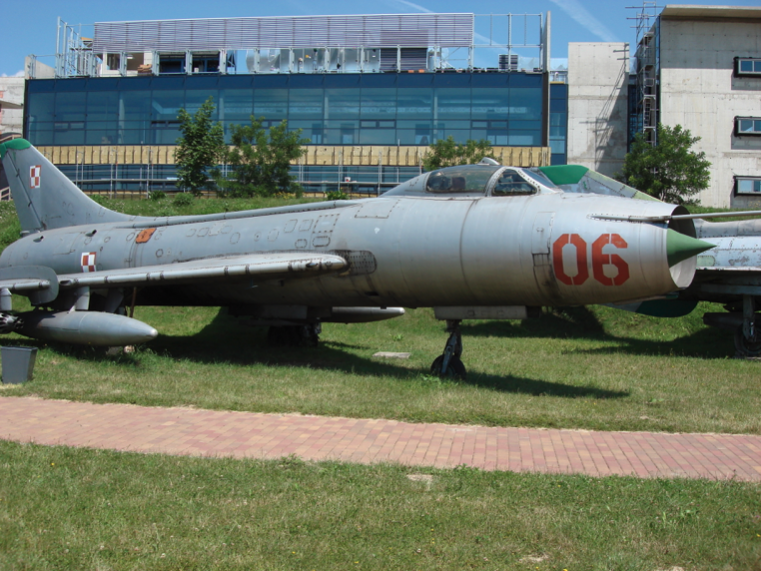
Two years after launching serial production of Su-7 B, a new version was developed, which initiated the creation of the S-22-2 prototype. This aircraft was to be the target version carrying nuclear weapons. At first, Su-7 B aircraft did not carry nuclear weapons, as such were just being made for them and were implemented in 1962. in the form of an 8U49 nuclear bomb, initially 5 kT, and then in various varieties from 1 to 10 kT.
S-22-2 received the bombardier sight PBK-1 (later PBK-2) automatically determining the moment of dropping the bomb, depending on the speed of the plane, height or angle of climb. Additionally installed: RSIU-5 W radio, low altitude radio altimeter RW-UM, automatic pilot AP-28J-1, new chair KS-3. The cabin received a red backlight.
The engine had an increased service life, initially up to 150 (AL.-7 F1-150) and then up to 200 hours of operation (AL.-7 F1-200).
The aircraft was designated Su-7 BM (M for modernized Russia).
All changes resulted in an increase in the aircraft's own weight of about 600 kg.
Nuclear weapons were tested on the S-22-2 aircraft - the 8U49 bomb was carried individually at the castle under the fuselage. The aircraft tested new conventional weapons in the form of FAB-500 M62 bombs, which with their slim figure were more suitable for supersonic flights displacing previously used M54 and M58. The APU-14U launcher was also abandoned (it had a large cross-section which influenced the air resistance and aircraft performance) and the PU-12 (the use of only the S-24 rocket with the PU-12-40U launcher was abandoned).
The S-22-2 aircraft configured in this way first rose into the air in 1962. The Su-7 BM aircraft appeared in battle regiments in 1963. It was produced until 1965, because the production of another newer version was launched this year. Su-7 BM is the first OKB Suchoj office aircraft to be used outside of CCCP. It is also the first version of Su-7, which was armed with the Polish Army.
Suchoj Su-7BKŁ (ros. Koliesno-Łyżnyj).
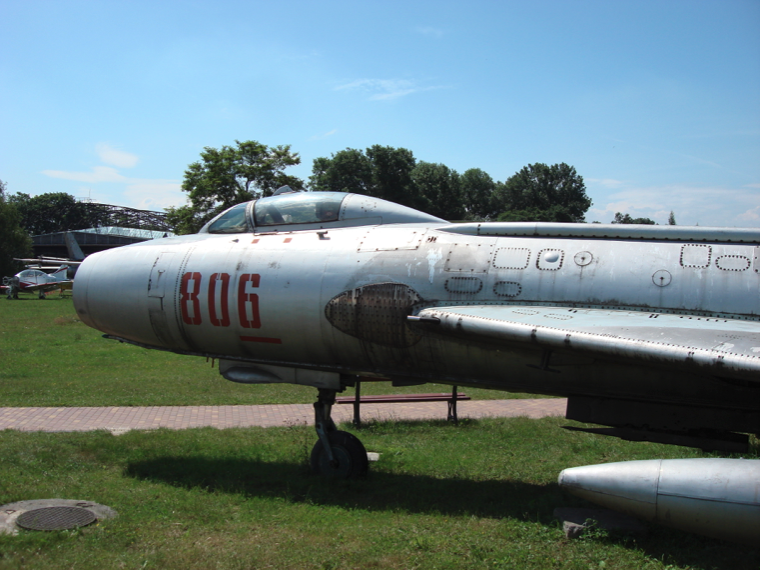
The Su-7 BKŁ version was developed on a wave of ideas by enabling heavy supersonic aircraft to use smaller airports without hard runways. Work on the Su-7 was carried out in two ways: work was carried out on both the rocket launch accelerators and skids at the wheeled chassis.
The first of these projects was based on the serial Su-7 B and marked as S-25 was created in 1960. The aircraft was characterized by two powder accelerators SPRD-110 mounted in the lower, middle part of the fuselage with a thrust of 1,300 - 3,000 kG (dependent on from air temperature) and working time 10-17 seconds. Their use by the pilot took place when the aircraft was accelerated to a certain take-off speed, after which, immediately after take-off and wear, they were dropped by means of pyroquoys.
The second road is a skid chassis, which has been working since 1959. There were various solutions. In one of the systems, the wheels were completely abandoned, leaving only skids. An oil supply installation was also used, which cooled the skids and prevented the skids from freezing to the ground.
Finally, the modified main chassis went into series production, receiving wheels and skids simultaneously. Production of the Su-7 BKŁ aircraft was carried out in 1965-1971. and ended with the construction of about 500 copies.
Suchoj Su-7 U (ros. Ucziebnoj).
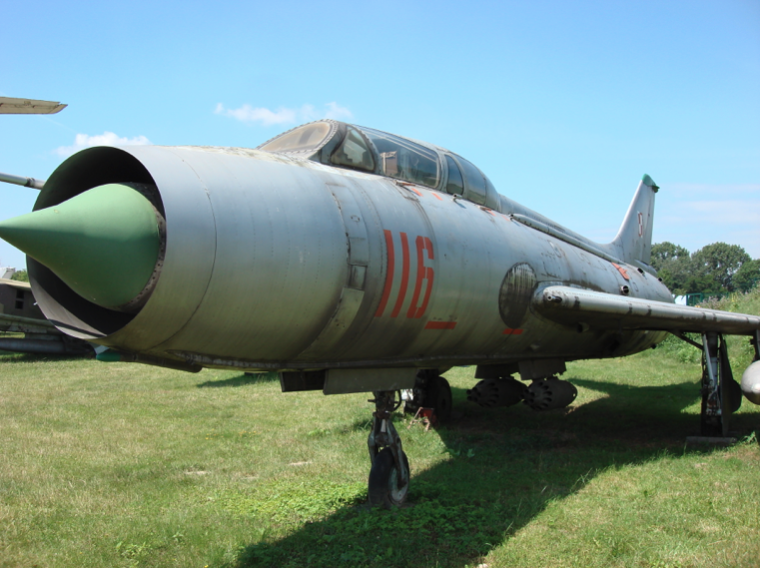
Due to problems with the first serial Su-7 B aircraft, the development of the school version was postponed. The lack of this aircraft caused a lot of problems in training young pilots on how difficult to pilot the Su-7 B.
Two prototypes of the school aircraft, designated U-22-1 and U-22-2, were created in the second half of 1965. The first serial aircraft rose in the air in April 1966. Its production was carried out until 1971.
The two-seater Su-7 U aircraft were based on the Su-7 BM aircraft. To build the second cabin in the fuselage, the front of the fuselage had to be lengthened by 200 mm. The cabins had two air-open covers. A periscope was installed in the second cabin.
The increase in mass of the entire Su-7 U aircraft caused restrictions in the carried armament, the maximum load capacity of the suspensions was limited to 2,500 kg, some machines did not receive a left-wing 30 mm caliber cannon. However, the possibility of carrying nuclear bombs was left. The sight used on the school plane is a modification with Su-7 BM marked as ASP-5ND-7U replaced by the newer ASP-PF-7U.
The Suchoj Su-7 aircraft in Poland. 1964.
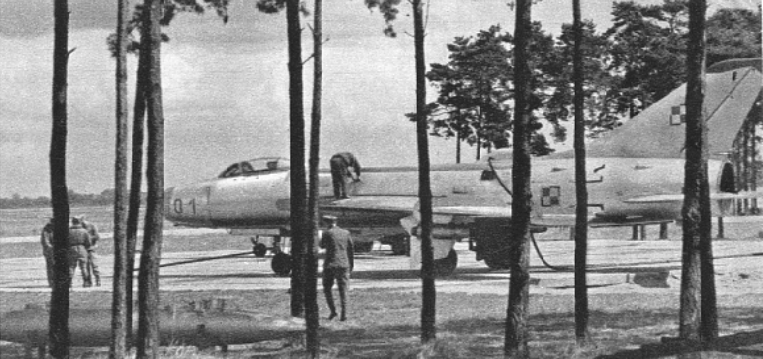
The decision to accept (purchase) the armament of Su-7 B aircraft was made at the turn of 1962-1963, and Bydgoszcz and the 5th Fighter-Assault Regiment were chosen as their stationing station. The original contract was for 36 single-seater and 6 school, two-seater machines, which constituted the crew of one regiment with three squadrons.
The Polish Army received the first 6 Su-7 BM (53 series) a few months after Czechoslovakia in June 1964. They were the only planes in the Su-7 BM version.
We received the next 12 Su-7 BKŁ in 1966. All these planes were located in Bydgoszcz.
Next deliveries are; 1968. - 2 Su-7 BKŁ , 1969. - 3 Su-7 U , 1971. - 4 Su-7 BKŁ, 1 Su-7 U , 1972. - 12 Su-7 BKŁ, 1973. - 1 Su-7 U. In the years 1974-1977. - 4 Su-7 U (delivered together with Su-20 to Powidz). In 1986 these aircraft were transferred to the 3rd Air Regiment in Bydgoszcz.
In the second half of the 1960s, a group of Polish pilots and technicians underwent special training in Soviet units in CCCP. This training was related to the use of nuclear weapons. The pilots trained the technique of bombardment from an ascending flight at low altitude. Imitation of a nuclear bomb was used for this purpose. A tactical nuclear bomb (called atomic at that time) called 6U-57 was carried on the left hook under the fuselage.
In Poland, Su-7 aircraft were used until June 1990. As a result of the Helsinki Agreements on the reduction of combat assets that could carry nuclear weapons, the Polish Su-7 was finally put to an end. Some planes were scrapped, but a significant number of them went to museums, mainly in 1994.
On March 6, 1992 a ceremonial demolition of the unit took place, at which the regiment's flag was farewell. On April 30, 1992 Regiment 3. Pomeranian Regiment of Training and Combat Aviation was dismantled.
As a result of various events, 1 Su-7 BM (1970), 5 Su-7 BKŁ (1969, 1982, 2 x 1984, 1987) and 1 Su-7 U (from 7 BB-R in Powidz) were lost. It is noteworthy that one Su-7 BKŁ nb 023 was handed over to the Czechoslovak aviation in exchange for a plane accidentally shot down by the Polish MiG-21 PFM in 1971. At the beginning of 1988 The Soviets gave Poland one copy of Su-7 BKŁ in exchange for the plane destroyed in 1987 by a Soviet pilot during a flight to a repair shop.
Written by Karol Placha Hetman
Kraków 2007-07-24
197 Section 1964-06-01
OKB Suchoj Su-7 B (BM, BKŁ, U)
Poland
Construction
Supersonic direct support aircraft and nuclear strike.
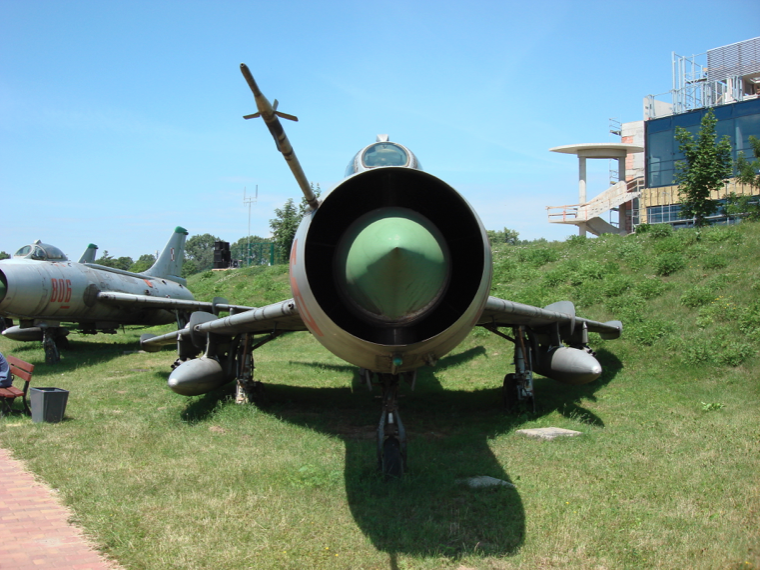
Construction Suchoj Su-7 BM
The Su-7 BM is a single-engine, single-seat, medium wing aircraft with an oblique wing. Not equipped with a radar station, but capable of performing operations in difficult weather conditions. All-metal construction, mainly made of aluminum and steel.
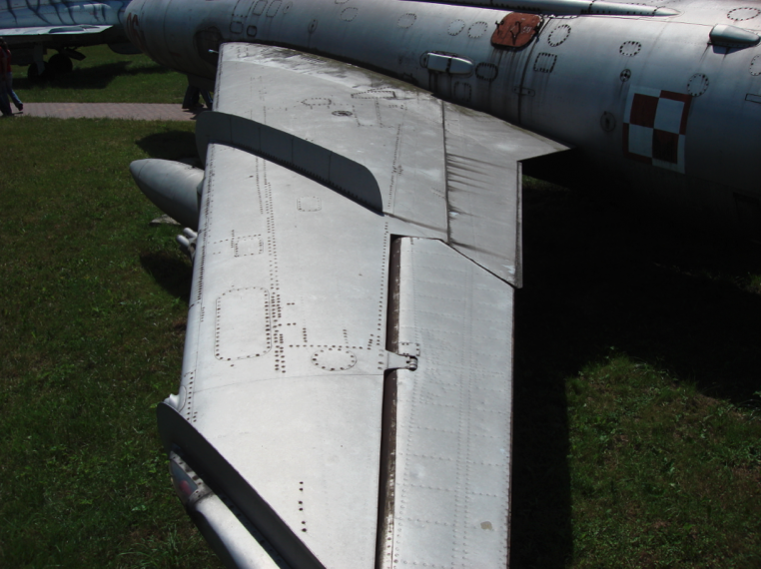
Double-girder wings with two auxiliary girders. The bevel angle of the leading edge is 60 degrees. Mounted at 0 wedge angle and has a negative rise of 2 degrees. The wings are equipped with two-piece, one-slot flaps with a sliding axis of rotation. "Flap wideners", ailerons and two pairs of aerodynamic steering wheels. Two 30 mm cannons were mounted at the base of the wings. Fuel tanks were placed in the wings. One armament hitch is mounted under the wings.
The circular fuselage begins with a central air grip, with a movable cone regulating the air supply to the engine. Single cabin. It protrudes from the fuselage outline. The cabin glazing consists of a permanent windscreen equipped with three windows (bullet-proof front with a flat glass) and a movable wind deflector manually moved back and equipped with a periscope to observe the rear hemisphere. Fire protection windows were used. KS-2 pilot seat, class 0/150. Behind the cab there is a compartment for equipment and fuel tanks. An engine was placed at the end of the fuselage. Four aerodynamic brakes of a rectangular shape are located at the rear of the fuselage. In the background of the fuselage a space for one braking parachute has been made. The rear of the fuselage is subtracted to replace the engine.
Plane tail horizontal plate, with a skew angle of 55 degrees and a relative thickness of 6 to 7%. Anti-flutter masses were added at the ends. The halves of the tail are interchangeable. Vertical plane of the aircraft divided into rudder and ballast.
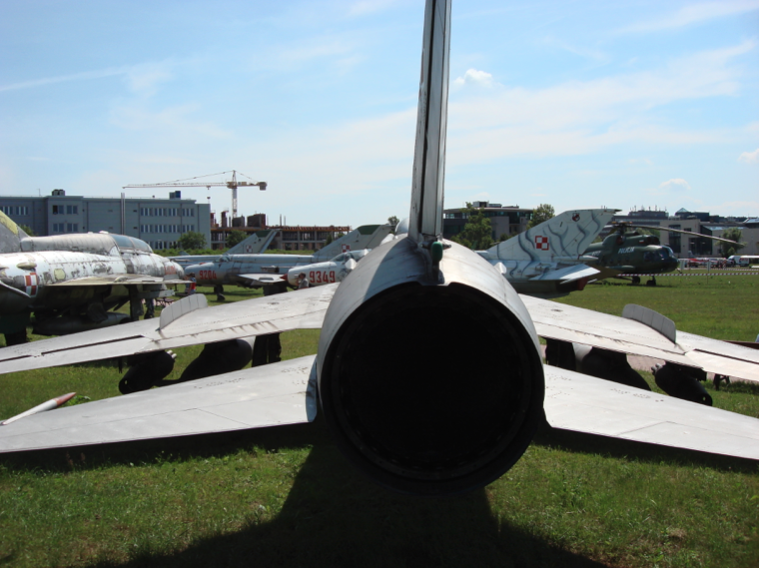
Three-support chassis. Chassis with front wheel. Retracted and released hydraulically. The front shin is equipped with a vibration damper, which also acts as a steering (turning) wheel. All wheels single. Oil-pneumatic shock absorbers. The front landing gear retracts towards the front and is covered by two symmetrical flaps. The main landing gear retracts towards the hull. The tires have a large diameter for the possibility of using ground airports and are high pressure. The main chassis distance is 3.83 m.

Su-7 BM drive
The propulsion of the aircraft is a turbojet, single-flow, single-shaft A. Lulki AL.-7 F-1 engine with 1 x 68.65 kN thrust. (1 x 7,000 kG.) With afterburning of 1 x 98.10 kN. (1 x 10,000 kg). It consists of a 9-stage axial compressor, ring-pitcher combustion chamber, 2-stage turbine, afterburner and adjustable nozzle. The engine is equipped with an oxygen system to facilitate starting on the ground at low temperatures or high in the air. The fuel installation is located in the wings and the fuselage and amounts to 2,940 liters. You can also hang 2 fuel tanks with a capacity of 2 x 600 liters under the fuselage or wings.
Initially, the AL.-7 F-1 (TRD-31) engine with 1 x 66.64 kN thrust was used. (1 x 6 800 kG.) With post-combustion 1 x 94.08 kN (1 x 9 600 kG.).
The aircraft may use SPRD-110 launch powder rockets with 2 x 29.40 kN thrust. (2 x 3,000 kG.).
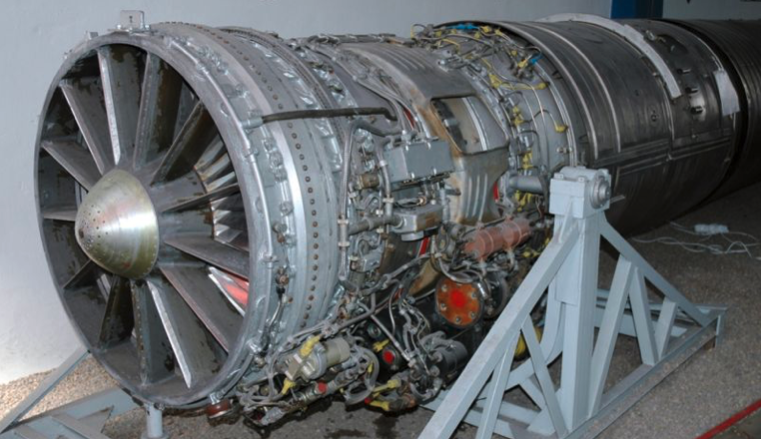
Utilities Su-7 BM
Two 30 mm NR-30 cannons.
The 4 arms hanging nodes (2 under the hull and 2 under the wings). The basic means of combat are UB-16-57U or UB-32-56U tanks with 16 or 32 57 mm S-5 shells, respectively. The machine can take up to 750 kg. bombs. The effects of the use of armament are recorded with a camera mounted in the right wing, near the fuselage.
Nuclear bombs were stored in Soviet warehouses for Polish aircraft in Poland.
Su-7 BKŁ version
Changes compared to Su-7 BM.
Aerodynamic steering wheels are reinforced on the wings. Under the wings appeared assembled since 1969, two additional hooks with a lifting capacity of 2 x 250 kg. A new KS-4 thrown chair, class 0-140, was used in the cabin. The front armored windscreen in the cabin is thinner for better visibility. Internal fuel supply increased. Aerodynamic brakes have been strengthened. The vertical arrangement has been slightly redesigned and strengthened. The main landing gear received skids. Landing is supported by two, not one braking parachute. The parachutes were placed in the container at the base of the vertical tail.
Su-7 BKŁ drive
The drive unit is the AL.-7 F-1-250 engine, whose service life has been extended to 250 hours. The engine weight is 2 103 kg. Fuel consumption 0.9 kg / kG / h. The drive unit is supported by SPRD-110 start accelerators with 2 x 29.40 kN (2 x 2 998 kG).
Construction Su-7 U
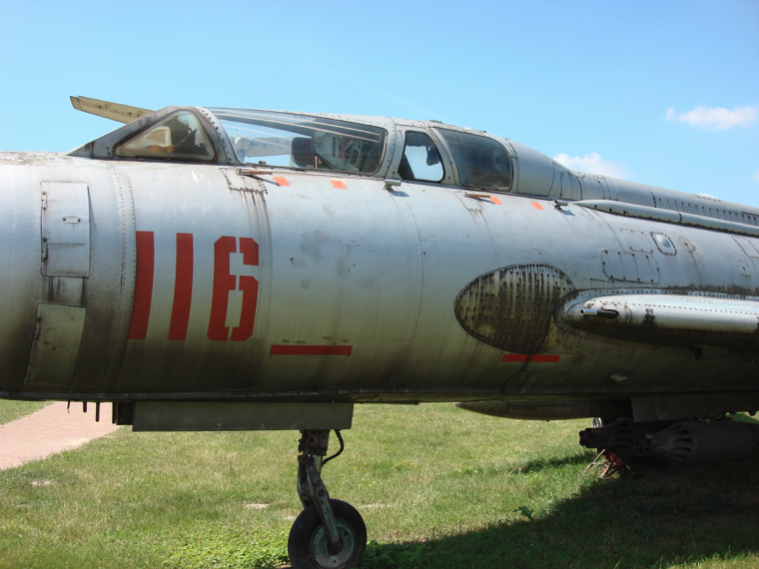
The basic difference between airplanes is the use of a two-person cabin in a tandem arrangement. The hull is 0.20 m longer. A superstructure was placed on the fuselage in which equipment moved from behind the pilot's cabin was placed. Despite the reconstruction of fuselage fuel tanks, its quantity is almost identical to the Su-7 BM version.
Individual cabin covers are lifted up to the rear pneumatically. The rear cabin is equipped with a folding periscope. Its mirrors are made of polished metal. The periscope can be used up to a speed of 600 km / h. (The reinforced version of the periscope is used up to a speed of 850 km / h).
The crew received a special version of KS-4 U-22 ejection seats, the first pilot's seat and then the instructor's seat always fired, regardless of who initiated leaving the plane.
The chassis (often treated badly by young pilots, especially during landings) and its brakes were strengthened. The front shin of the chassis was equipped with brakes and could be controlled hydraulically. The chassis braking system has received a system that sprinkles alcohol with wheel hubs for more efficient cooling.
The increase in the weight of the aircraft caused restrictions in the armament carried, the maximum suspension capacity was limited to 2,500 kg, some machines did not receive a left-wing 30 mm cannon. However, the possibility of carrying nuclear bombs was left. The sight used on the school plane is a modification with Su-7 BM marked as ASP-5ND-7U replaced from 12 production series by a newer ASP-PF-7U.
Data Suchoj Su-7 B
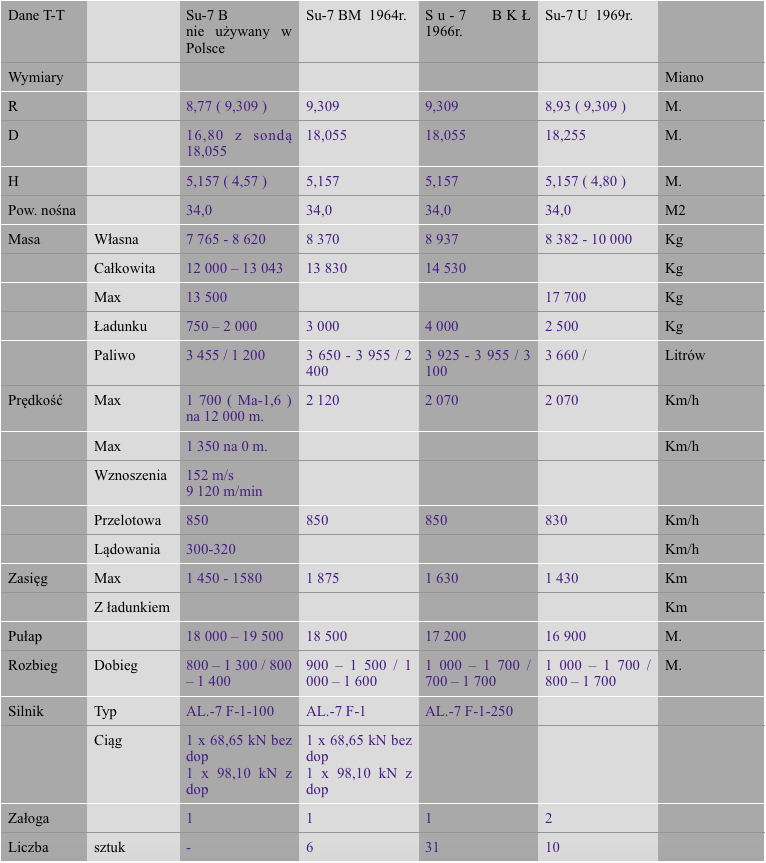
Written by Karol Placha Hetman
Kraków 2007-07-24
197 Section 1964-06-01
OKB Suchoj Su-7 B (BM, BKŁ, U)
Poland - Tally
Su-7 B in Poland
The decision to accept (purchase) the armament of Su-7 B aircraft was made at the turn of 1962-1963, and Bydgoszcz and the 3rd air regiment were chosen as the place of their stationing. The original contract was for 36 single-seater and 6 school, two-seater machines. Our air forces received their first 6 Su-7 BM (53 series) a few months after Czechoslovakia in June 1964.
We received the next 12 Su-7 BKŁ in 1966. All these planes were located in Bydgoszcz.
Next deliveries are; 1968. - 2 Su-7 BKŁ, 1969. - 3 Su-7 U, 1971. - 4 Su-7 BKŁ, 1 Su-7 U, 1972. - 12 Su-7 BKŁ, 1973. - 1 Su-7 U.
In the years 1974-1977. - 4 Su-7 U (delivered together with Su-20 to Powidz).
In 1986 these aircraft were transferred to the 3rd Air Regiment in Bydgoszcz. 1984. - 1 Su-7 U.
Tally
1/1 Su-7 MB nb 01 No. 5301 - delivered to Poland in June 1964. after serving, handed over to the museum in Czyżyny.
2/2 Su-7 MB nb 02 No. 5302 - delivered to Poland in June 1964. Lost in 1970.
3/3 Su-7 MB nb 03/3117 No. 5303 - delivered to Poland in June 1964. After leaving the service on 1990-02-04, left as an exhibit in Bydgoszcz from nb 3117.
4/4 Su-7 MB nb 04 No. 5304 - delivered to Poland in June 1964.
5/5 Su-7 MB nb 06 No. 5306 - delivered to Poland in June 1964. After leaving the service, handed over to the Museum in Czyżyny.
6/6 Su-7 MB nb 09 No. 5309 - delivered to Poland in June 1964.
7/1 Su-7 BKŁ nb 11 No. 6011 - delivered to Poland in 1966.
8/2 Su-7 BKŁ nb 12 No. 6012 - delivered to Poland in 1966. After leaving the service, handed over to Łódź-Lublinka. In 2012, he was transferred to the Air Force Museum in Dęblin.
9/3 Su-7 BKŁ nb 13 No. 6013 - delivered to Poland in 1966. After leaving the service, it was handed over to the Czerniaków Fort Museum in Warsaw.
10/4 Su-7 BKŁ nb 17 No. 6017 - delivered to Poland in 1966. After leaving the service, it was handed over to the Czerniaków Fort Museum in Warsaw.
11/5 Su-7 BKŁ nb 20 No. 6020 - delivered to Poland in 1966.
12/6 Su-7 BKŁ nb 22 No. 6022 - delivered to Poland in 1966. After leaving the service, handed over to Łódź-Lublinka. In 2012, he was transferred to the Air Force Museum in Dęblin.
13/7 Su-7 BKŁ nb 23 No. 6023 - delivered to Poland in 1966. Handed over to Czechoslovak aviation in exchange for a plane accidentally shot down by the Polish MiG-21 PFM in 1971.
14/8 Su-7 BKŁ nb 24 No. 6024 - delivered to Poland in 1966. Lost in 1969.
15/9 Su-7 BKŁ nb 26 No. 6026 - delivered to Poland in 1966.
16/10 Su-7 BKŁ nb 28 No. 6028 - delivered to Poland in 1966.
17/11 Su-7 BKŁ nb 30 No. 6030 - delivered to Poland in 1966.
18/12 Su-7 BKŁ nb 32 No. 6032 - delivered to Poland in 1966.
19/1 Su-7 BKŁ No. 515 - delivered to Poland in 1968.
20/2 Su-7 BKŁ No. 516 - delivered to Poland in 1968. After leaving the service, handed over to the museum in Czyżyny.
21/1 Su-7 U nb 115 - delivered to Poland in 1969. The first training and combat Su - in the Polish Army.
22/2 Su-7 U nb 116 - delivered to Poland in 1969.
23/3 Su-7 U nb 117 - delivered to Poland in 1969.
24/1 Su-7 BKŁ - delivered to Poland in 1971.
25/2 Su-7 BKŁ - delivered to Poland in 1971.
26/3 Su-7 BKŁ - delivered to Poland in 1971.
27/4 Su-7 BKŁ - delivered to Poland in 1971.
28/1 Su-7 U - delivered to Poland in 1971. After serving at the Museum of Polish Military Technology, Czerniaków Fort in Warsaw.
29/1 Su-7 BKŁ nb 806 No. 7806 - delivered to Poland in 1972. After leaving the museum in Czyżyny.
30/2 Su-7 BKŁ nb 807 No. 7807 - delivered to Poland in 1972. After leaving the museum in Czyżyny.
31/3 Su-7 BKŁ nb 808 No. 7808 - delivered to Poland in 1972.
32/4 Su-7 BKŁ nb 809 No. 7809 - delivered to Poland in 1972. After finishing service in Skarżysko Kamienna.
33/5 Su-7 BKŁ nb 811 No. 7811 - delivered to Poland in 1972.
34/6 Su-7 BKŁ nb 813 No. 7813 - delivered to Poland in 1972. After leaving the service, handed over to Łódź-Lublinka. In 1997 as a wreck. In 2012 he went to the museum in Dęblin.
35/7 Su-7 BKŁ nb 815 No. 7815 - delivered to Poland in 1972. After leaving the service, handed over to the Museum of Polish Military Technology, Czerniaków Fort in Warsaw.
36/8 Su-7 BKŁ nb 817 No. 7817 - delivered to Poland in 1972.
37/9 Su-7 BKŁ nb 818 No. 7818 - delivered to Poland in 1972.
38/10 Su-7 BKŁ nb 819 No. 7819 - delivered to Poland in 1972.
39/11 Su-7 BKŁ nb 820 No. 7820 - delivered to Poland in 1972.
40/12 Su-7 BKŁ nb 821 No. 7821 - delivered to Poland in 1972.
41/1 Su-7 U nb 502 No. 3502 - delivered to Poland in 1973.
42/1 Su-7 U nb 513 No. 3513 - delivered to Poland in 1976. The aircraft was built on 18.08.1971, accepted for armament on 07.07.1976. On 16.03.1982. lost in 7 PLB-R in Powidz. Pilots Bogdan Likus and Igor Urbaniak catapulted successfully.
43/2 Su-7 U nb 702 No. 3702 - delivered to Poland in 1976.
44/3 Su-7 U nb 706 No. 3706 - delivered to Poland in 1976.
45/4 Su-7 U - delivered to Poland in 1976.
46/1 Su-7 U nb 905 No. 2905 - delivered to Poland in 1984. Production date: 18.08.1970. In 1970 delivered to the CCCP Air Force. 16.06.1984 transferred to the Polish Air Force, to 7 PLB-R Powidz. March 24, 1986 in 3 PLB Bydgoszcz. 4.02.1990 aircraft transferred to the museum in Dzierżoniów.
47/1 Su-7 BKŁ nb 926 No. 7926 - delivered to Poland in 1988. Passed in exchange for damaged. At the beginning of 1988 The Soviets gave Poland one copy of Su-7 BKŁ in exchange for the plane destroyed in 1987. by a Soviet pilot during a flight to a repair shop. After leaving the service, handed over to Opole Nowa Wieś.
Summary
In total, we operated 6 Su-7 BM, 31 Su-7 BKL, 10 Su-7 U. Su-7 aircraft were operated until June 1990, when as a result of armament reduction they were withdrawn and most were transferred to museums.
Losses during operation; As a result of various events, 1 Su-7 BM (1970), 5 Su-7 BKŁ (1969, 1982, 2 x 1984, 1987) and 1 Su-7 U (from 7 BB-R in Powidz in on March 16, 1982).
Written by Karol Placha Hetman
